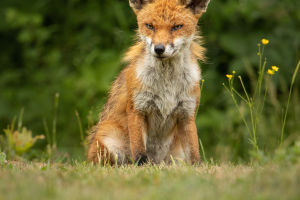The white fox is a neighbor of the polar bear and has lived in the Arctic for generations. It is the special climate and environment of the Arctic that sets the white fox apart from other species of foxes. Why is it related to the environment?
Because all species in the natural world are in competition every day, and animals are constantly competing to find the right way to survive. If you have skin similar to the environment, you can effectively avoid natural predators, and at the same time, you will have the opportunity to kill your own prey.
The white fox, also known as the Arctic fox, is much smaller than other species of foxes, and its small size saves it a lot of energy loss.
Because of the low temperatures and sparse biology in the Arctic, the Arctic fox usually hunts in the sea just like the polar bear. Each hunt requires 30% of its body weight to be consumed in order to meet the body's energy requirements. If the body size is too large, the heat loss is faster, which undoubtedly increases the time for the Arctic fox to hunt.
However, white foxes actually change their fur twice a year. In the winter the Arctic fox puts on its snow-white fur, and in the summer the color of the fur is similar to that of the tundra. There are even blue arctic fox variants in Iceland and Greenland. In the winter, the fur of the Arctic fox is even warmer than that of the polar bear.
The Arctic is not all ice and snow, there is also greenery at the very edge of the Arctic Circle. Such places are also the most frequented by Arctic foxes. Arctic foxes cannot live on the ice for long periods of time, so their nests are built on hills in the tundra zone.
The white fox is the master builder of the animal kingdom, and its nests are dry and breezy all year round.
In the event of a snowstorm, the Arctic fox can stay in its nest for days at a time. Year after year, the Arctic fox makes some repairs and extensions to its nest so that it can live in it for a long time. Many buildings in human society are modeled after their nest, and such buildings are widely loved by people once they are built.
In summer, when food is plentiful, the white fox stores some of its food in its den. In winter, when the food stored in the den is depleted, the white fox will follow the polar bear and pick up the leftovers.
So in winter, there are always 2 or 3 white foxes quietly stalking behind the polar bear. But when a polar bear is very hungry, it will also attack the fox.
The Arctic fox's diet includes lemmings, fish, birds and eggs, berries, and Arctic rabbits. Sometimes it will roam the coast to catch shellfish, but the lemmings are the mainstay of the fox's diet.
When the Arctic fox smells a lemming's nest or hears a lemming screaming in a lemming's nest, it will quickly dig into the nest under the snow. The fox will jump up high and use the force of the leap to eat the lemmings in the nest. In cases of extreme hunger, the Arctic fox will also attack itself.


